Because ALS is steadily taking away my body's function, my wife Linda and I have been traveling as much as we can manage since I won't be able to do this forever. One of the trips that was high on our list was taking a safari. On the recommendation of a family member, we engaged with the Africa Travel Center out of Colorado. They listened to our wishes and my accessibility needs, and were able to set up an adventure that worked for me in my wheelchair.
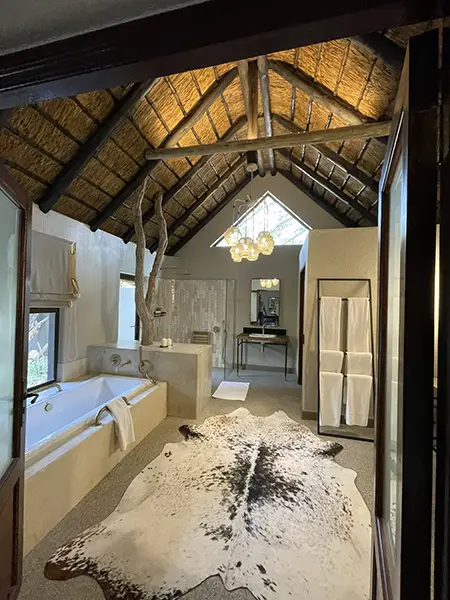
All of this took place at the Sabi Sabi Bush Lodge, a private game reserve just outside of Kruger National Park in South Africa. The lodge is almost fully accessible, including a room that worked well for my needs. I was able to get into the safari vehicle using a robust boarding platform, and I could have used the passenger seat if I had been unable to make my way up the platform stairs. They also have a SitSafe harness available for people who need upper body support. Finally, they were receptive to my feedback and said they would look at addressing some accessibility concerns for future guests who use wheelchairs.
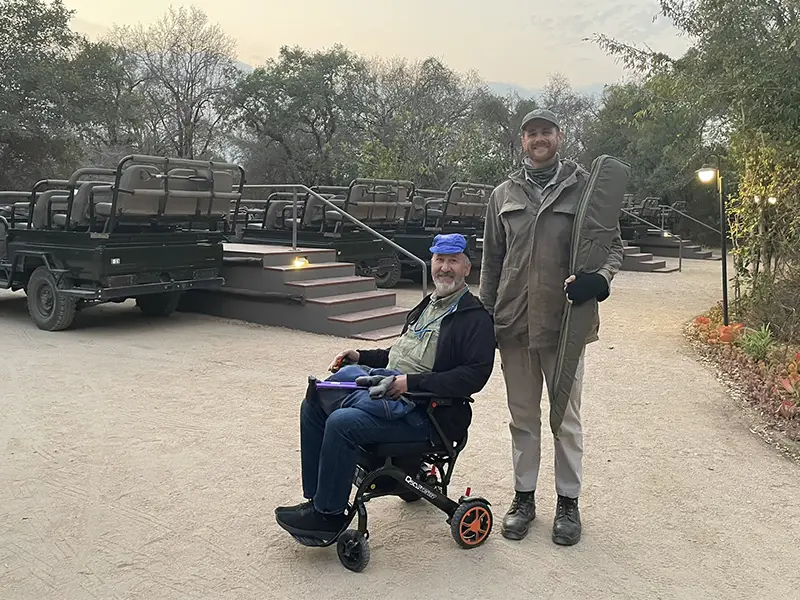
This post is about one memorable day out of our week-long safari. We started at sunrise to look for a leopard kill that had been reported from the prior night. We drove for about 30 minutes before our guide, Alex, pointed to a pair of skinny antelope legs handling from a branch. This is what we were seeking – leopards bring their kills into trees to protect them from scavengers. Moments later, we watched a hyena rear up against the tree trunk, pull the carcass down, and drag it away from the tree. Alex maneuvered our vehicle to follow her from a safe distance.
Watching the hyena eat was quite a visceral experience. We could hear flesh and skin ripping as the hyena pulled off chunks. We also heard bones crunching because hyenas have incredibly strong jaws that allow them to chew through bones and get to the marrow. Periodically, the wind would carry a whiff of the dead animal to us, adding to the experience.
Meanwhile, we saw the leopard walking towards the tree where he expected to find his hard-won meal. When he saw that it wasn't there, he sniffed around the tree before heading in the hyena's direction. We weren't sure if he would fight to retrieve his prey, but like us, he just observed from a distance while the hyena ate. Eventually, the hyena grabbed what looked like a leg bone and walked away with it, probably to chew through it for more marrow, and left the rest of the carcass behind.
We were surprised at how patient the leopard had been about another animal eating his conquest. Alex told us that animals make judgments about the risk of the food that they're pursuing. This leopard had probably eaten well enough that getting the carcass back wasn't worth the risk of getting injured by an angry hyena. He may have made a different decision if it had been a time with less food available.
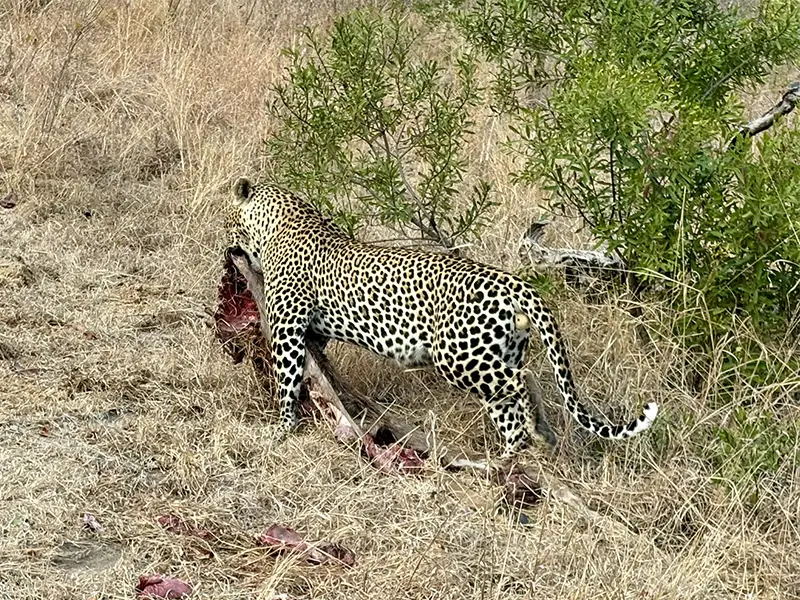
After the hyena left, the leopard walked over to the remains and took a few bites before picking it up and dragging it back towards the tree. We watched him leap gracefully onto a low branch, dragging the carcass with his mouth. He then leapt onto a higher branch where he deposited the meat before climbing back down.
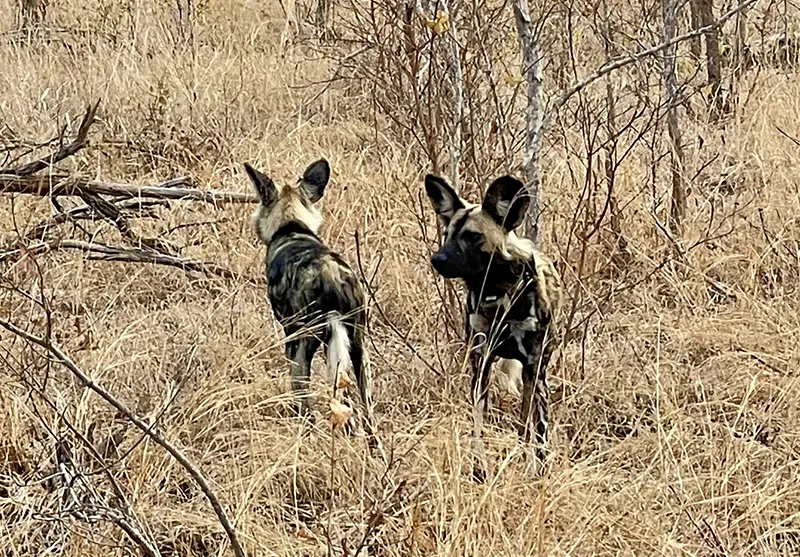
We left the leopard at that point and went in search of some rhinos that we had seen while we were watching the hyena eat. Our tracker, Solomon, was easily able to track their progress, so owe found them and enjoyed watching these prehistoric-looking beasts for a while. Another highlight of the morning was finding a pair of African wild dogs to observe. It was interesting that there were also two hyenas and two vultures keeping watch over these beautifully mottled canines. Because they are efficient hunters, they are often followed by scavengers waiting for a likely kill that they can partake of.
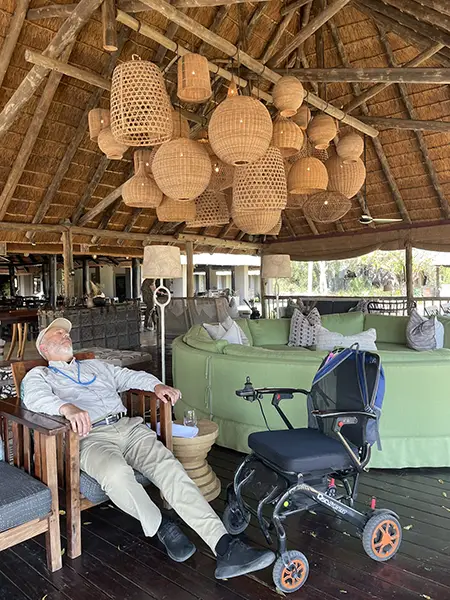
After the wild dogs, we returned to the lodge for breakfast and a rest. As the afternoon started to cool off, we headed out again. We started by watching a tiny baby elephant and his mother. Did you know that baby elephants need to learn how to use their trunks? We watched his one trying to copy his mom's amazing trunk versatility as she wrapped her trunk around a patch of grass like we might twist spaghetti onto a fork. She ripped the bunch out by the roots. The baby tried to do the same and got just one wispy strand. Mama used her trunk to slap the bunch of grass against her shoulder a few times to knock the dirt from the roots before popping it in her mouth. Baby slapped his piece of grass and it went flying from his grasp. He grabbed another wisp and swung his trunk up right past his mouth and poked the wisp into his eye. Another try and it was the other eye before the wisp blew away again. Eventually the baby gave up. He walked to the female, curled his trunk back over his head so it looked like a snorkel, the nosed under her foreleg to suckle. So cute!
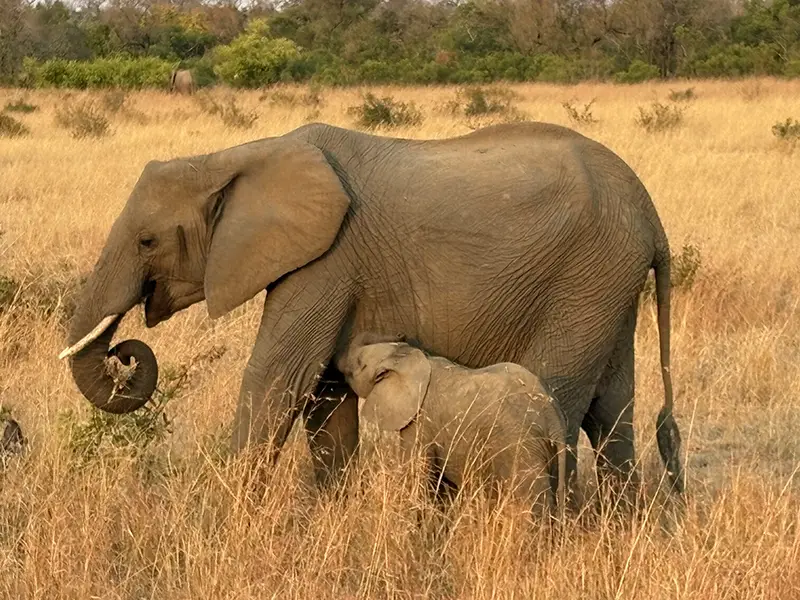
As it approached sundown, we returned to see what was happening with the leopard in the tree. We found the carcass still hanging and the leopard lying in the grass nearby. After about 20 minutes of resting and preening, he stood, stretched, and marked his territory by scraping the ground with his rear paws before squatting and spraying. Apparently, the marking urine smells like caramel popcorn, of all things.
By this time, it was dark and Solomon used his spotlight to illuminate the leopard. The animals around here are so used to vehicles and lights that he didn't seem to react at all to being lit up. He sauntered back to the tree and leapt up to the branch with the kill. We watched him eating in the tree for about 15 minutes before leaving so another group of safari guests could have the experience.
We felt fortunate to have had this full circle observation across the range of the day. Watching the drama of nature in process is awesome! These encounters and many more, including our watching a pride of lions killing and eating two warthogs, are in my travel blog. It was an amazing and memorable trip, and thanks to the lodge's accessibility setup, it was an experience I could fully participate in from my wheelchair.
About the author
David Buseck has been an avid traveler his whole life, as has his wife, Linda Levine. He was diagnosed in 2019 with a slow-moving form of ALS, but has been committed to continuing his traveling for as long as feasible. He's been using a wheelchair while traveling since May 2022, and with a QUICKIE Q50 R Carbon since September 2024. David retired from a career in technology & education and is now an author and blogger. His book, Paris: City of Cultures, Walk and Roll with Fresh Eyes, was published in 2024. It's a guidebook to Paris, focusing on wheelchair-accessible walking tours through beautiful Parisian neighborhoods while learning about different cultural groups who live(d) or work(ed) there. His blog about travel and living with ALS is LindaDavidTravel.com. David and Linda live in San Jose, California with their two pet tortoises.
David's ride is a QUICKIE Q50 R Carbon.
Most of the stories here on LiveQuickie.com were submitted by readers. Do you have a story to tell? We'd love to hear it. Submit your story here.